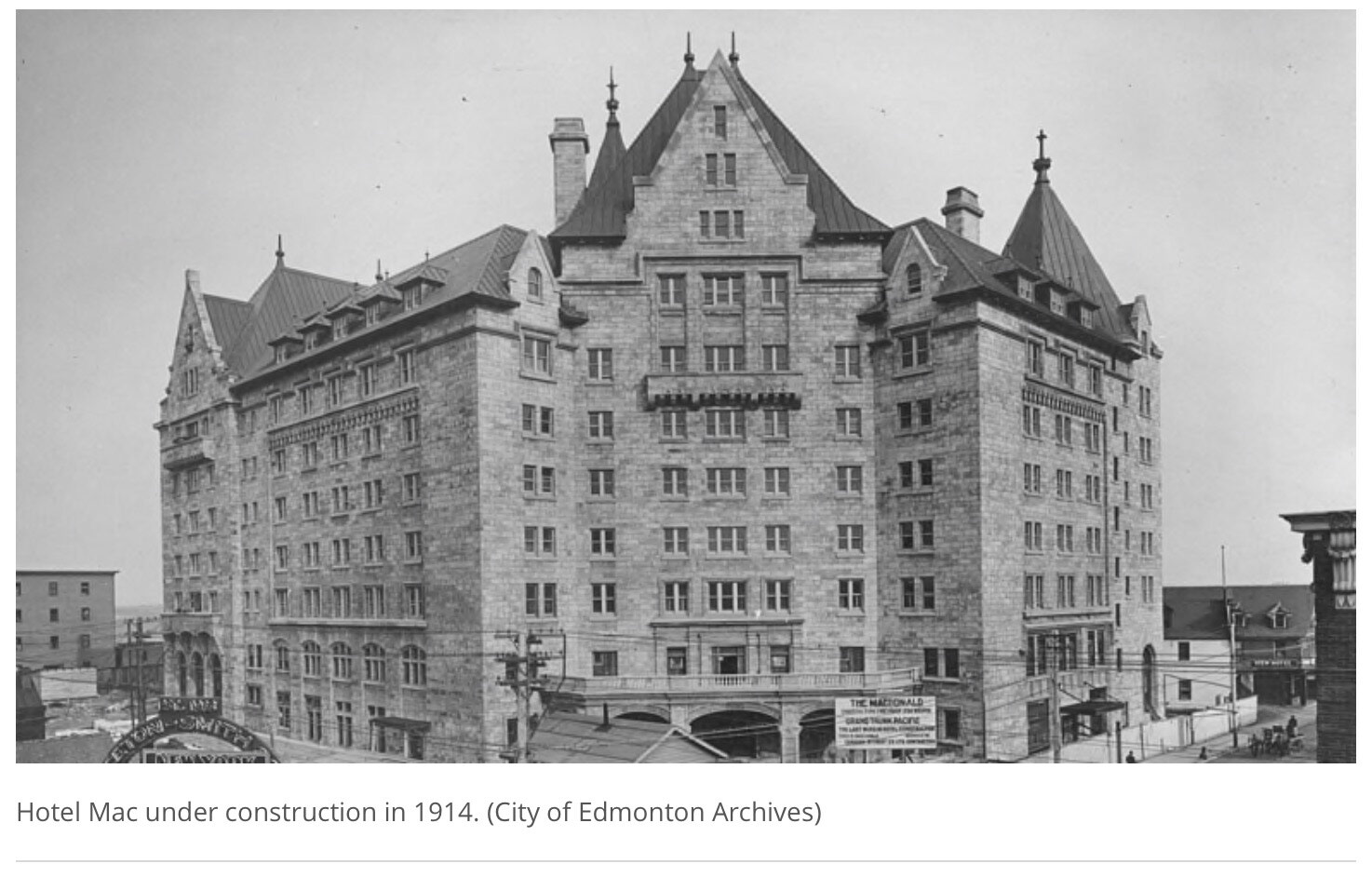Capital foundations: Excavating Edmonton's architectural history
'These hotels imported norms and social etiquette to the wilds of Canada'
CBC News · Posted: Jul 04, 2018 1:57 PM MT | Last Updated: July 1
Hotel Mac under construction in 1914. (City of Edmonton Archives)
The following story is part of Capital Foundations, an ongoing series exploring Edmonton's architectural history.
Listen in weekly on CBC Radio's Edmonton AM for the latest episode, and for a little excavation of Edmonton history with architect Darrel Babuk.
If only the walls could talk.
In the more than a century since it was constructed during the wild days of the Canadian West, Edmonton's Fairmont Hotel Macdonald has survived ruin and near demolition to remain a jewel in the city skyline.
The landmark hotel, built by the Grand Trunk Pacific Railway, opened 1915 on the bank overlooking the North Saskatchewan River valley.
The castle-like structure, with grand arches, corbelled balconies and rugged stonework, was seen as a symbol, said Darrel Babuk, an Edmonton-based architect with Boreas Architecture & Civic Design.
'Truly regal'
Designed in the style of French 16th century castles, the hotel brought a sense of grandeur to a city where coal, rail and hard labour still reigned supreme.
 "Chateauesque is very interesting in terms of what it represents," Babuk said as he walked the hotel grounds in downtown Edmonton.
"Chateauesque is very interesting in terms of what it represents," Babuk said as he walked the hotel grounds in downtown Edmonton.
The building was designed by American architect Bruce Price, father of author Emily Post, famed for her books about etiquette and good manners that were the rage at the turn of the 20th century.
"These hotels imported norms and social etiquette to the wilds of Canada," Babuk said. "It's truly regal. It's a little bit of British history that got put in Edmonton."
With a total price tag of more than $2 million, the hotel was designed to impress.
When construction began in 1912, the work pushed out a camp of squatters who had occupied the land. From the start, the project was plagued by difficulties. Within two years, young men were being conscripted to fight overseas in the Great War, shrinking the pool of skilled labourers and the city population, Babuk said.
But Charles Hayes, the expansionist Grand Trunk president, was unwavering in his bid to build a chain of six sister hotels for the railway across Canada. So he went to London to raise money.
Smudge, the Hotel Macdonald's friendliest greeter
In a fateful meeting overseas, he pitched his plan to businessman Bruce Ismay, chairman of the now-infamous White Star Line.
"Bruce Ismay was so taken with the presentation that Charles Hays gave," Babuk said, "that he offered first-class tickets to Charles Hays and his entourage, his family, to come back to North America on their brand new ocean liner, the Titanic."
Hays's daughter and wife survived on lifeboats. He was among more than 1,500 people who drowned on April 15, 1912, when the British passenger liner sank in the North Atlantic during its maiden voyage.
"Charles Hays thought the boat would stay afloat for at least 10 hours, so he stayed on with his son-in-law and his secretary and did not make it out."
May 15, 1991: Hotel Macdonald reopens after 8 years
The rail company remained unshaken in its commitment and construction on the hotel was completed in the summer 1915.
The decades to come saw numerous galas, concerts and star-studded guest lists. Many celebrities and dignitaries have graced the hotel's corridors, including Queen Elizabeth II, Archbishop Desmond Tutu, the Rolling Stones and U2.
'Look to history'
Hotel Mac came into being at the height of what was called the "city beautiful movement," a time when the urban planning philosophy "loved beauty for beauty's sake," said Babuk.
Had the movement been successful, modern Edmonton might look a lot like Washington, D.C.
"It spoke a lot to a civic ideal of making things better than they were," he said.
While the hotel still stands, the lofty design ideas that surrounded its construction were soon forgotten in the post-war exhaustion, which plagued the people and the economy of the West, said Babuk.
A consideration for beauty in design was soon abandoned in favour of practicality. The hotel itself later faced financial ruin.
The Hotel Macdonald closed in 1983 and was nearly demolished before it was designated a historic resource and restored to its former elegance.
The lesson to be learned from the history of Edmonton's grand hotel, said Babuk, is build beautiful, build it to last, and preserve what you can.
"If we were to look to history, we would realize the mistakes that we're making," he said. "Beautiful cities start with great, almost philanthropic statements like this, of building great buildings and landscapes.
"Even though I'm a fan of brutalism, I would definitely say, more Hotel Macs."

